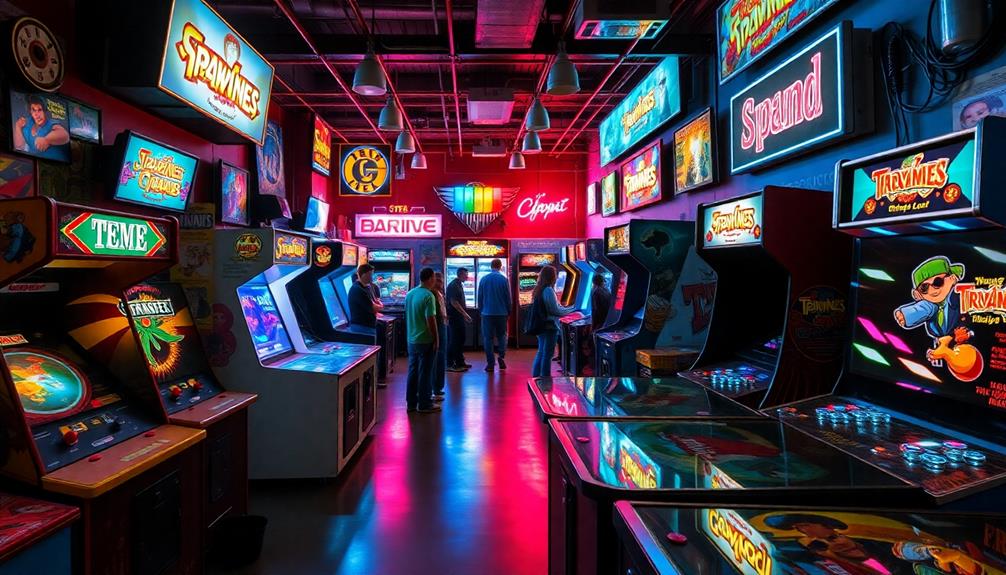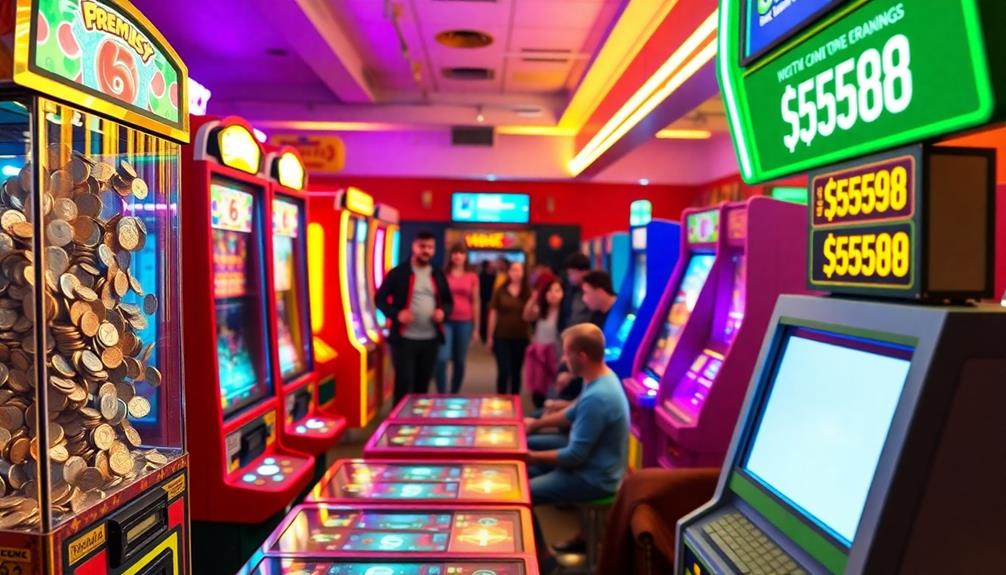Arcade games captivate players with their simplicity, accessibility, and strong social elements. They do not require any technical skills, making it easy for anyone to join in and enjoy without lengthy tutorials. The nostalgic charm of classic games invokes cherished childhood memories, while multiplayer features promote friendly competition and teamwork. Players can indulge in a variety of games based on skill or chance to satisfy different preferences. Moreover, modern innovations such as VR and 3D graphics enhance the experience, keeping it engaging and dynamic. If you are interested in exploring how these components influence your arcade experience, there is plenty more to uncover.
Key Takeaways
- Arcade games are accessible to all ages, requiring no technical knowledge, making them easy to enjoy for everyone.
- They offer low entry costs, allowing players to engage in fun without significant financial investment.
- Nostalgia plays a significant role, with classic games evoking fond memories that enhance player engagement.
- Social interaction is fostered through multiplayer options, creating community hubs for friends and family to enjoy together.
- The simplicity of mechanics provides immediate fun and entertainment, eliminating the need for lengthy tutorials.
The Appeal of Arcade Games
Arcade games have a unique charm that draws people in, and it's easy to see why they've remained popular over the years. One of the biggest reasons is their accessibility. You don't need any technical knowledge to play arcade games, making them perfect for players of all ages and skill levels. The low entry cost means you can enjoy quick gaming sessions without breaking the bank.
Additionally, the resurgence of classic games alongside modern innovations, such as those found in best-rated pinball machines, keeps the arcade experience exciting and diverse.
Another appealing aspect is the nostalgic factor. Many people fondly remember spending hours at arcades during their childhood, creating a strong emotional connection to these games. This sense of nostalgia often brings you back to simpler times, enhancing your gaming experience.
Multiplayer games further boost the appeal of arcade games by fostering social interaction. You can challenge friends or collaborate with family, creating memorable experiences that deepen those connections.
Plus, the simplicity of arcade game mechanics allows you to jump right in without a steep learning curve. You can easily engage and enjoy immediate fun without a long tutorial.
With continuous advancements in technology, arcade games remain fresh and exciting, ensuring that everyone can find something they love, whether they're a casual player or a tech-savvy gamer.
Types of Arcade Games

When you explore arcade games, you'll find they fall into distinct categories, each offering a unique experience.
From skill-based games like pinball to chance-driven redemption games like Skee-Ball, there's something for everyone.
Many modern arcade machines also incorporate advanced technology to enhance gameplay, making them appealing to both casual and serious gamers.
Understanding these dynamics can enhance your enjoyment and strategy as you play, especially when considering options like best arcade machines for home game rooms.
Game Categories Overview
In the vibrant world of gaming, various types of arcade games offer something for everyone, each category providing a unique experience. Among the most popular are classic arcade games, which include beloved pinball machines that have a rich history dating back to their origins in France.
These games have evolved tremendously since their inception, combining mechanical and electronic elements to enhance gameplay, with advancements like electronic scoring introduced in the 1970s. You'll also find redemption games, where you can earn tickets that can be exchanged for prizes, making them a favorite among players of all ages.
Skill-based games, like Skee-Ball, challenge your abilities and reward precision, often found in redemption settings. In contrast, coin-operated machines like slot machines, though primarily games of chance, have a limited presence in traditional arcades.
Another interesting category is photo booths, particularly purikura, which allow you to create customizable stickers, turning a simple photo into a fun keepsake.
Pachinko, a popular Japanese game, blurs the lines between skill and chance, offering both recreation and gambling. Each of these categories contributes to the diverse landscape of arcade games, ensuring that there's something for everyone to enjoy at your local arcade.
Skill vs. Chance Dynamics
Many players enjoy the excitement of skill-based games and the thrill of chance-based games in the arcade. Skill-based games, like pinball and Skee-Ball, rely heavily on your player ability. Your strategies and reflexes directly influence your success, making each play feel rewarding. Understanding common financial terms can also enhance the experience, as players may invest their money into these games.
On the other hand, chance games, such as slot machines and pachinko, depend more on luck, where the outcome is unpredictable and out of your control.
Redemption games blend these elements, rewarding players with tickets or prizes based on performance, enhancing engagement and competition. This dynamic encourages skill improvement, as you aim for higher scores to earn better rewards.
The distinction between skill-based and chance games is vital, especially regarding gambling laws. Skill games are typically more accepted in arcade settings, while chance games may face stricter regulations due to their gambling nature.
Technological advancements and game design shifts, like the introduction of flippers in pinball machines, have transformed perceptions of these games. Notable examples, such as Street Fighter II, showcase how skill-based dynamics can create intense competition, contrasting sharply with the random outcomes found in chance-based arcade machines.
Historical Development and Impact

The evolution of arcade games showcases a captivating journey through entertainment history, marked by innovation and cultural impact. You can trace the roots of arcade games back to the 19th century, where coin-operated machines began to emerge at fairs and amusement halls. This progression gained momentum with the introduction of pinball machines in 1933, which, despite initial gambling classifications, became wildly popular.
Notably, similar to how astrology influences attractiveness, arcade games have long been intertwined with social dynamics, influencing how people interact and build communities around gaming.
Key milestones in this development include:
- The debut of Atari's Computer Space in 1971, which heralded the age of arcade video games.
- The release of Pong in 1972, greatly broadening the audience for arcade games.
- The golden age of the 1980s, featuring iconic titles like Pac-Man and Donkey Kong, which not only revolutionized gaming but also permeated pop culture.
- Continuous adaptation to technological advancements, leading to innovations such as 3D graphics in the early 1990s.
These elements highlight how arcade games evolved, transforming from simple skill-based machines to complex video games that shaped entertainment trends and cultural identity.
The impact of this evolution is still felt today, as arcade gaming remains a beloved pastime.
Skill vs. Chance in Arcade Gaming
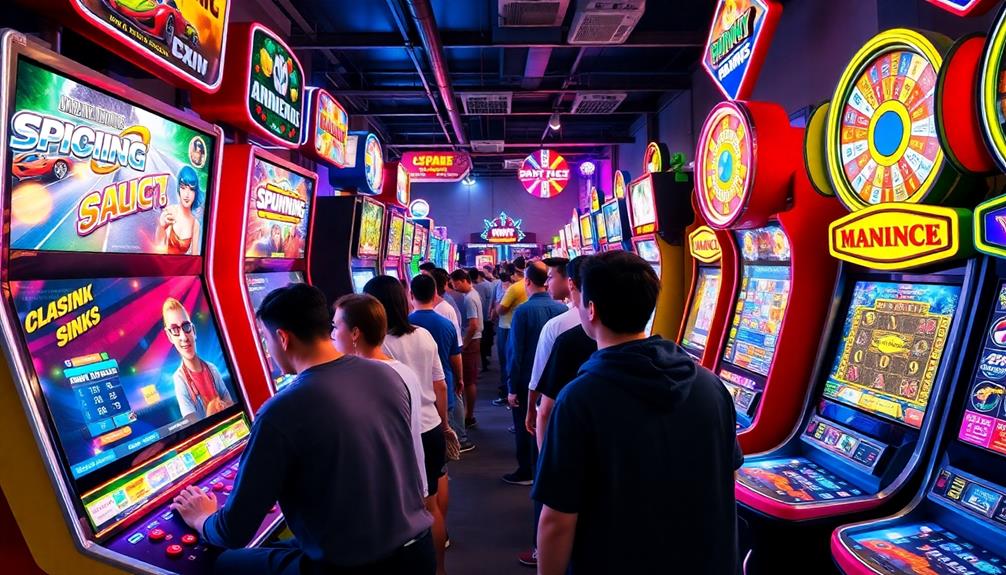
While some arcade games rely heavily on your skills, others leave outcomes largely to chance, creating a diverse gaming experience. Skill-based games, like pinball and Skee-Ball, require your player performance to directly influence results, making them engaging and competitive.
On the other hand, chance-based games, such as slot machines and pachinko, depend more on luck, appealing to those who enjoy unpredictable outcomes. This combination of skill and chance mirrors investment strategies in precious metals, where understanding market trends can enhance returns. Additionally, the regulatory compliance surrounding these games can be compared to the legal and financial regulations governing IRA rollovers, highlighting the importance of following rules for successful outcomes.
This distinction between skill and chance greatly impacts how these games are regulated. Skill games are generally more accepted in arcades, while chance games often fall under gambling laws, leading to stricter regulations.
Redemption games, a popular subset of skill-based arcade games, reward you with tickets based on your performance, blending both skill and luck to enhance the fun.
The introduction of the electric flipper in pinball machines in 1947 shifted their classification from chance to skill games, ensuring their continued popularity. Despite the prevalence of skill components in many arcade games, the presence of chance elements can attract a broader audience, catering to those who appreciate the thrill of luck in their gaming experiences.
Social Interaction and Community
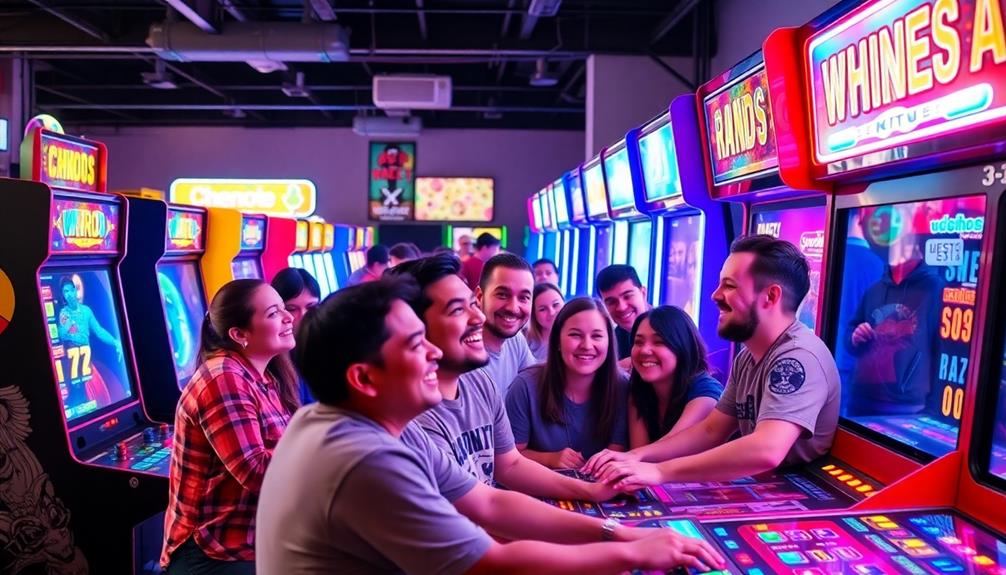
Arcades have become vibrant social hubs where friends and families gather to enjoy games and foster connections. The atmosphere buzzes with excitement as players engage in multiplayer games, leading to meaningful social interactions and a tight-knit community.
In addition to the fun, many arcades offer special events and themed nights that enhance the overall experience, akin to the unique tastes found on cruise ships like Carnival Venezia.
Here are some key aspects that highlight this dynamic environment:
- Events and Tournaments: Arcades frequently host competitions, drawing large crowds and strengthening community ties through shared experiences.
- Teamwork and Competition: Many arcade games encourage collaboration and healthy rivalry, allowing players to bond over victories and defeats alike.
- Diverse Connections: Arcades are inclusive spaces where individuals from various backgrounds can come together, promoting social engagement and interaction.
- Social Media Integration: Players often share achievements and scores online, creating a sense of belonging and camaraderie within the arcade community.
Through these elements, arcade games transcend mere entertainment, turning into a platform for social engagement.
You'll find that the sense of community in arcades enriches your gaming experience, making every visit not just about winning or losing, but about connecting with others.
Nostalgia and Its Influence
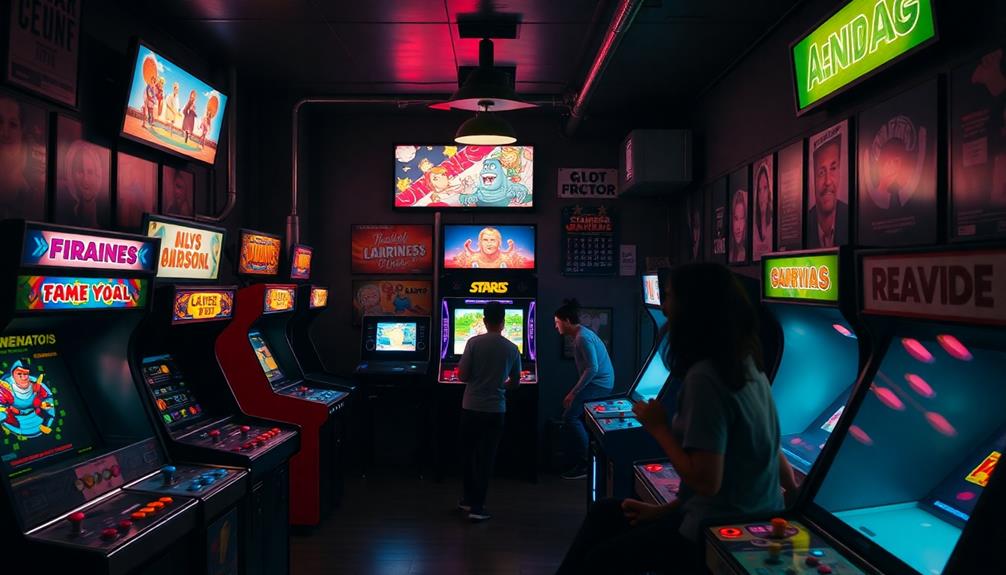
Nostalgia plays a powerful role in shaping your arcade experience, bringing back fond memories of simpler times. When you sit down to play classic arcade games like Pac-Man or Space Invaders, you're not just engaging with the game itself; you're tapping into your childhood experiences during the peak of arcade popularity in the 1980s.
This emotional connection can evoke feelings of happiness and a sense of belonging, enhancing your overall mental wellbeing as you engage with these timeless classics. The retro aesthetics and straightforward gameplay of these games appeal to both older generations and younger players discovering them for the first time.
As you navigate the pixelated worlds, you're reminded of the joy and excitement that once filled your weekends. Nostalgia marketing cleverly leverages familiar imagery and themes from iconic games to attract players, enhancing that connection to the past through the power of imagination.
Today, many adults revisit arcades to relive those cherished memories, contributing to the resurgence of adult-targeted arcades that blend gaming with social experiences. Engaging with nostalgic media like arcade games not only rekindles old memories but also reinforces your well-being.
Technological Innovations in Arcades
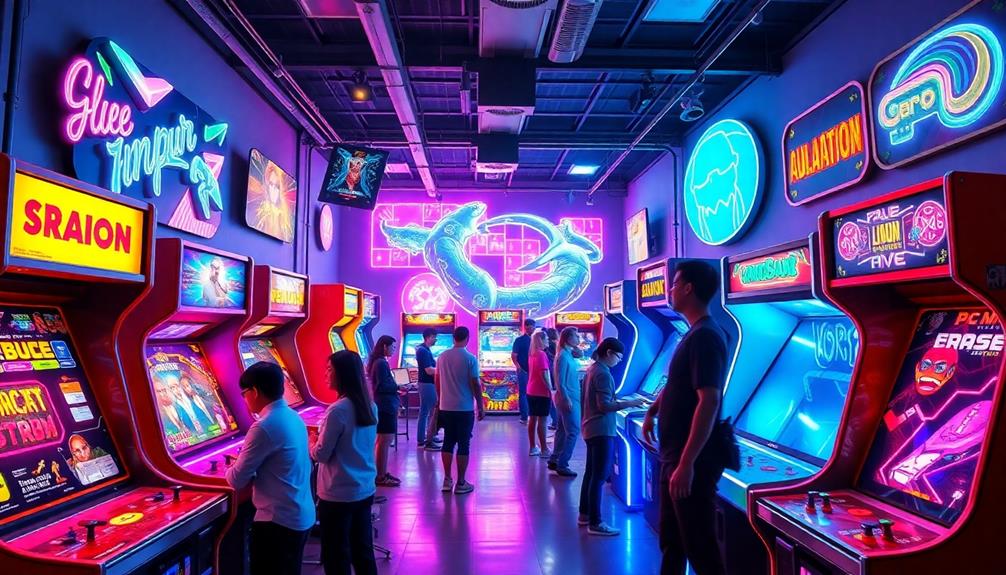
You've likely noticed how arcade gaming has evolved dramatically over the years, driven by technological innovations that keep players engaged and excited.
With advancements in technology, arcade games have transformed into immersive experiences that captivate audiences. For instance, AI-Powered Virtual Reality in E-Learning showcases how similar technologies can enhance user engagement.
Here are some key innovations that have shaped the landscape:
- 3D Graphics: The introduction of 3D graphics in the early 1990s, seen in titles like Virtua Racing, revolutionized gameplay, enhancing both visual appeal and complexity.
- Virtual Reality: VR games have emerged, offering players a unique, immersive environment that traditional setups can't replicate.
- Motion Simulation: Advanced arcade systems, such as Sega Model 3, introduced motion simulation, elevating the thrill of gameplay and showcasing the power of arcade machines over home consoles.
- Touchscreens and Mobile Tech: The integration of touchscreens has broadened gameplay possibilities, resulting in more interactive experiences that keep players coming back.
These technological innovations guarantee ongoing consumer excitement and interest, making arcade gaming a continually evolving adventure.
As you step into an arcade, you're not just playing; you're experiencing the cutting-edge of gaming technology.
Future of Arcade Gaming
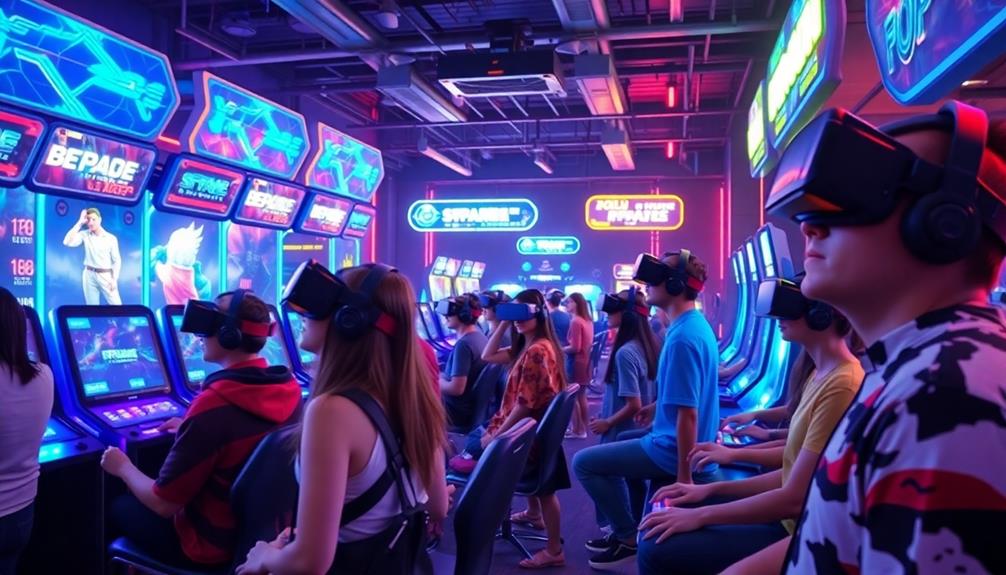
As technology continues to advance, the future of arcade gaming looks incredibly promising. With innovations like virtual reality (VR) and augmented reality (AR), you can expect to see more immersive experiences that pull you into the action of arcade games. Competitive gaming, especially e-sports, is breathing new life into arcade-style play, attracting passionate communities enthusiastic to participate.
Manufacturers are responding with new arcade titles that blend classic gameplay mechanics with cutting-edge technology. Plus, nostalgia-driven arcades, often called barcades, cater to adults seeking a social experience reminiscent of their youth.
Here's a glimpse of the future landscape:
| Trend | Impact on Arcade Games | Examples |
|---|---|---|
| Technological Advancements | Enhances user engagement | VR/AR experiences |
| Competitive Gaming | Revitalizes interest in arcade play | E-sports tournaments |
| New Arcade Titles | Attracts diverse audiences | Innovative game designs |
| Nostalgia-Driven Arcades | Fosters social experiences | Barcades |
| Networking Opportunities | Encourages collaboration among developers | Industry trade shows |
Frequently Asked Questions
Why Do People Play Arcade Games?
You play arcade games for the thrill of competition, the joy of simple mechanics, and the chance to connect with friends. Nostalgia and the challenge of beating high scores keep you coming back for more.
Why Are Arcade Games Still Popular?
Arcade games are like timeless classics, enchanting you with their nostalgic charm. Their accessibility, social interaction, and ongoing innovations keep you engaged, while multiplayer fun creates lasting memories with friends, making them a beloved entertainment choice.
What Is the Purpose of an Arcade Game?
The purpose of an arcade game is to entertain you, create social connections, and spark friendly competition. They offer immediate gratification, accessible gameplay, and a nostalgic experience, making them engaging for everyone involved. The benefits of arcade games also extend to cognitive and motor skills development, as players must think quickly and use hand-eye coordination to succeed. Additionally, arcade games can provide a break from everyday stress and offer a fun, lighthearted way to unwind. Overall, the social, cognitive, and emotional benefits of arcade games make them a popular form of entertainment for people of all ages.
Why Are They Called Arcade Games?
They're called arcade games because they originated in amusement arcades, where people gathered to play coin-operated machines. The term highlights the social aspect, encouraging you and others to enjoy gaming together in dedicated spaces.
Conclusion
To sum up, arcade games continue to captivate and charm players of all ages. Their blend of bold graphics, gripping gameplay, and communal camaraderie creates an unforgettable experience. As technology transforms, the thrill of the arcade persists, promising new adventures for future fans. So, whether you're rekindling nostalgia or discovering dynamic designs, immerse yourself in the dazzling world of arcade games and enjoy the exhilarating excitement they offer. It's a splendid spectacle you won't want to miss!
